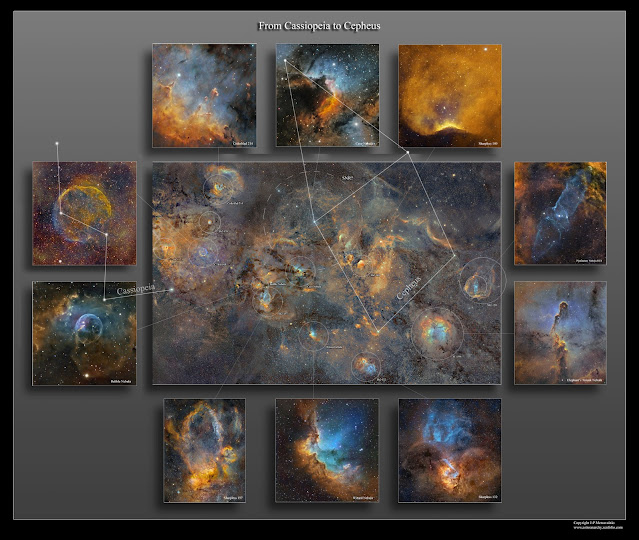COPYRIGHT, PLEASE NOTE
Thursday, December 10, 2020
Cirrus of Cygnus and the supernova remnant W63
The dim are in the Western Cygnus is very much overlooked, the reason must be the there are so many brighter and well known astronomical objects just nearby.
Hydrogen filaments in the image are about thousand light years long, the blue ring in the image is a rarely seen dim and large supernova remnant, the ring structure is seen only in light of an ionized oxygen (O-III)
I haven't seen any photos focusing to this area beside my older shots of it. This new composition is reprocessed and more data is added, specially in O-III channel. This image is a part of new unpublished mosaic image, it'll cover the whole Cygnus complex.
Image is shot with several instruments between 2010 and 2020, Original frames from 2010-2013 are shot with canon EF 200mm f1.8 camera lens and QHY9 astro camera with Baader narrowband filter set. Additional wilde filed frames are shot with Tokina AT-x 300mm f2.8 camera lens and Apogee Alta U16 astro camera and Astrodon narrowband filters. Many details in the image are sot with Celestron Edge 11" telescope and an old Meade LX 200 GPS 12". total exposure time is around 150 hours. I gave the name "Cirrus of Cygnus" since this gas formation remains me about Cirrus clouds.
Cirrus of Cygnus
You should click the image to see it in full resolution, it's worth it! (3000 x 1250 pixels)
Orientation
click the image to see it in full resolution
An older long focal length photo of the supernova remnant
G82.2+5.3 W63 the "Cygnus shell"
click the image to see it in full resolution

Image is in mapped colours, from the emission of ionized elements, R=Sulphur, G=Hydrogen and B=Oxygen. This mosaic image of twelve individual panels covers about four degrees of sky vertically.
More info about this photo here, https://astroanarchy.blogspot.com/2018/10/a-very-rare-photo-cygnus-shell.html
Friday, December 4, 2020
Cassiopeia mosaic gets larger, now up to Cepheus
I started this imaging project at Spring season 2020m now I have shot more frames for this active region of the sky. At center of the photo lays the Bubble and cave nebula At lower left locates the Cederblad 214 and just few degrees to right from it lays the supernova remnant CTB1, it can be seen as a thin ring like formation. The Wizard nebula can be seen at upper right corner of the image. Note. there is a moon as a scale at a lower left corner of the image. This is a large area of space and I I have now join this mosaic image to a large one from 2012. I will continue this mosaic soon!
There is an interesting looking dim and large circular formation at center left, there is a bright star at almost center of it. Could this be an uncataloged supernova remnant?
Total exposure time is now around 150 hours, if older exposures are included. with my current wide field imaging system build around the Tokina AT-x 300 mm f2.8 camera optics. Astro Don 50x50 mm square narrowband filters, 5nm H-alpha, 3nm O-III and 3nm S-II. Camera is a massive Apogee Alta U16.
Click for a much large image, it's worth it! (1400 x 2200 pixels)
Start of this imaging project at this year
Click for a large image

Image info, https://astroanarchy.blogspot.com/2020/03/from-bubble-to-cave-nebula-area.html
Sunday, November 29, 2020
Cassiopeia mosaic gets larger
I started this imaging project at Spring season 2020m now I have shot more frames for this active region of the sky. At center of the photo lays the Bubble and cave nebula At lower left locates the Cederblad 214 and just few degrees to right from it lays the supernova remnant CTB1, it can be seen as a thin ring like formation. The Wizard nebula can be seen at upper right corner of the image. Note. there is a moon as a scale at a lower left corner of the image. This is a large area of space and I will join this mosaic image to a large one, I have shot it back in 2012.
There is an interesting looking dim circular formation at upper left, there is a bright star at almost center of it. Could this be an uncataloged supernova remnant?
Total exposure time is now around 50 hours with my current wide field imaging system build around the Tokina AT-x 300 mm f2.8 camera optics. Astro Don 50x50 mm square narrowband filters, 5nm H-alpha, 3nm O-III and 3nm S-II. Camera is a massive Apogee Alta U16. This mosaic has now ten frames.
Clouds of Cassiopeia
Click for a much large image, it's worth it!
Click for a large image
 More info about this image here, https://astroanarchy.blogspot.com/2020/03/from-cassiopeia-to-cepheus.html
More info about this image here, https://astroanarchy.blogspot.com/2020/03/from-cassiopeia-to-cepheus.html
Start of the imaging project
Click for a large image

Image info, https://astroanarchy.blogspot.com/2020/03/from-bubble-to-cave-nebula-area.html
Monday, November 23, 2020
A new photo of Sharpless 132 (Sh2-132)
I have shot this beautiful target in Cepheus several times with a different focal length instruments. This time I have shot it with my current setup build around Tokina AT-x 300mm f2.8 https://astroanarchy.blogspot.com/2020/01/the-frankenstein-monster-my-current.html
Sharpless 132 in Cepheus
Click for a large image
A closeup
Click for a large image
Older shots with a large instrument
Click for a large image

Image is shot at 2019 and it's a four panel mosaic, more info in this blog post, https://astroanarchy.blogspot.com/2019/02/sharpless-132-sh2-132.html

Image is shot at 2014 and it's a four panel mosaic, more info in this blog post, https://astroanarchy.blogspot.com/2014/11/a-furious-cosmic-horse-gets-blinded-by.html
Technical details
5nm H-alpha 3nm S-II and 3nm O-III
H-alpha, 6 x 1200 s, binned 1x1 = 2 h
O-III, 3 x 1200 s, binned 1x1 = 1 h
S-II, 3 x 1200 s, binned 2x2 = 1 h
















